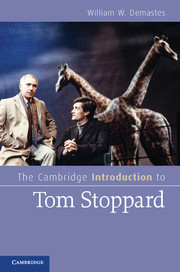Book contents
- Frontmatter
- Contents
- Illustrations
- Acknowledgements
- Introduction: Stoppardianism
- Professional chronology
- Chapter 1 Stoppard: briefly, a life in the theatre
- Chapter 2 Keys to Stoppard’s theatre
- Chapter 3 The breakthrough years
- Chapter 4 Playing with the stage
- Chapter 5 Science takes the stage
- Chapter 6 Love is in the air
- Chapter 7 Politics humanized
- Conclusion: The play’s the thing
- Appendix Stoppard’s theatre: a summary
- Notes
- Guide to further reading
- Index
Conclusion: The play’s the thing
Published online by Cambridge University Press: 05 December 2012
- Frontmatter
- Contents
- Illustrations
- Acknowledgements
- Introduction: Stoppardianism
- Professional chronology
- Chapter 1 Stoppard: briefly, a life in the theatre
- Chapter 2 Keys to Stoppard’s theatre
- Chapter 3 The breakthrough years
- Chapter 4 Playing with the stage
- Chapter 5 Science takes the stage
- Chapter 6 Love is in the air
- Chapter 7 Politics humanized
- Conclusion: The play’s the thing
- Appendix Stoppard’s theatre: a summary
- Notes
- Guide to further reading
- Index
Summary
The notes, the notes! The notes is where the fun is!
Indian Ink (4)In a 2001 assessment, Enoch Brater observes that Stoppard’s “best stage effects depend on an audience ‘there’ to meet him (at least) half way.” Brater then asks the question that likely haunts many theatregoers as they enter Stoppard’s theatre and cast glances at fellow patrons taking seats around them: “Just how specialized . . . is Stoppard’s audience?” (212).
Going to a Stoppard play, I suggest, does become a richer experience if we bring some degree of expertise with us to the theatre. But it is not the case that we need to be university dons in order to enjoy the plays that Stoppard spices with such intellectual esoterica as quantum physics, nineteenth-century European history, chaotics, catastrophe theory, literary theory, logical positivism, life at Elsinore Castle. Stoppard himself goes so far as to declare that his plays are stand-alone experiences. When asked if he had any advice to give on approaching his plays, he responded: “the plays declare themselves and there is nothing I want to add to the experience. I am not claiming any mystique for understanding the plays, so I can’t demystify them. They’re supposed to work just by being what they are, and I don’t think of them as being ‘difficult.’” Not everyone would entirely agree with his assessment, though it may in fact be true that we would enjoy Stoppard’s work more fully if we stopped worrying about the many peripheral factual details that occupy so much space in his theatre.
- Type
- Chapter
- Information
- The Cambridge Introduction to Tom Stoppard , pp. 136 - 137Publisher: Cambridge University PressPrint publication year: 2012



